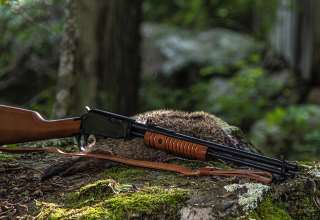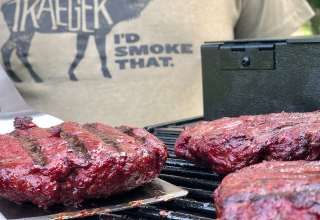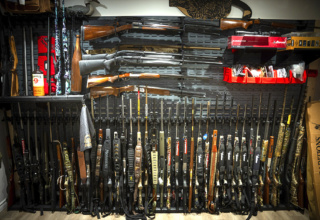Hunters are better prepared for the unknown. Three months ago, few had even heard of the coronavirus and no one expected indefinite isolation. Here’s why you should consider becoming a hunter and enjoying benefits far beyond having meat to feed your family.
by Brad Fenson
It was not that many generations ago when people had to hunt, fish, and forage for survival. Up until the 1950s, there were still nomadic people wandering the Arctic, living traditional lifestyles and living off the land. These northern people were eventually forced to settle in communities. Two things happened. Those that embraced living on the land still ventured out to use their passed-down knowledge and to maintain their preferred diet. Others settled and became reliant on someone else to provide for them.
It is often hard for modern man to fathom that people were living off the land and generating their own food, water, and shelter under such extreme conditions. When humans figured out how to domesticate livestock, store produce, and live in a fixed location, there was a sigh of relief. Civilizations bloomed. Fast forward to today. For the most part, society is no longer directly connected with the land and its potential bounty. Even the basic understanding of where food comes from seems to have become lost on many. This especially includes understanding the benefits of wild foraging and hunting.
It is difficult to explain to a non-hunter why I hunt. It is more than a passion or a pastime; it helps define me. Satisfaction is not generated from a kill, but from the processing of meat to feed my family. The sense of accomplishment is a bonus.
Why Would Someone Start Hunting?
Is hunting a learned trait or could it be in our DNA? Being exposed to hunting at an early age, I have embraced it my entire life. Today, there is a subtle shift developing in North America, where eating wild game is vogue, and the trend of hunters focused on the harvest of protein is on the rise. Many consider themselves “meat hunters” and do not set out looking for the largest set of antlers or horns. And when you can maximize the amount of wild game you put away for the year, unexpected things like a pandemic are a little less frightening.
In a reversal of sorts from our forebears’ experience, an increasing number of people who have been raised as non-hunters are questioning their complete reliance on others. They are starting to ask questions.
“Why didn’t I learn how to hunt?”
“Are the hormones and antibiotics used to raise domestic animals the best choice for daily meals?”
“Is there a way I can still become a hunter?”
The questions become real and important during times like the COVID-19 pandemic.
Hunters Benefit Society
Hunters provide benefits to all of society on an annual basis, with long-term rewards. Hunting licenses and the sale of many products required to hunt generate millions of dollars that conserve our land and water quality. Does the average citizen, utterly dependent on the grocery store, even have a clue why it is essential to have conserved landscapes? When one turns on the water tap, do they understand that water quality is not a given?
Hunters have a strong connection to their food and understand what those species require to survive. Some might think it is a selfish act to build and maintain habitat for deer, then head to the woods to shoot one. The benefits to society, however, far outweigh the one deer that is used to feed a family. Everything from carbon sequestration to the aesthetics in North America can be attributed to the love and respect for eating wild game.
Hunters Support
Hunters also put their money where their mouth is, supporting conservation groups that go even farther to protect habitat and wild species. Ducks Unlimited, Delta Waterfowl, and Rocky Mountain Elk Foundation are but a few examples of organizations that work to benefit society as a whole while receiving significant funding from the hunting community.
Hunters are proud to be part of efforts to maintain wild spaces and animals that benefit all of society. What would the landscape look like, and who would place value on wildlife, if hunting did not exist?
At the turn of the century, when market hunting was popular for feeding the masses, wildlife populations declined, and some species were even wiped out. It was hunters who turned this around and continue today to support wildlife habitat conservation by responsibly harvesting the precious resources they protect.
Why Eat Wild Game?
Did you know that wild game has more protein and less fat than popular domestic meats? In just 100 grams, or 3.5 ounces, of raw deer meat, there is 120 calories of energy, 23 grams of protein, and just 2.4 grams of fat. Another benefit is a moderate cholesterol count of 85 mg per serving.
Wild meat is lean protein and low in fat — an outcome of the animal’s higher level of activity as well as its natural diet. Wild animals roam free, eat a variety of feed, breed naturally, and are not treated with antibiotics, making them organic by nature.
Why is wild game a healthy choice? Let’s play a little Jeopardy, considering the pandemic.
I Will Take Organic for $100
A hunter’s version of the popular television game show Jeopardy could have some interesting questions and answers.
Answer: This form of lean animal protein is considered the original organic meat.
Question: What is wild game?
Answer: Settlers used this method to economically source the original organic meat.
Question: What is hunting?
Now for the Daily Double
Answer: This meal is a natural, heart-smart choice.
Question: What is grilled deer steak?
Today’s winner is the average hunter who scores valuable protein while enjoying time in the field. Wild game is not “finished” in a feedlot or barn, and fat does not marble through their meat.
Cook Wild Game Properly
Wild game offers a healthy source of protein while providing a lower environmental impact than domestic animals, however, there is a learning curve for proper cooking. Here are some tips.
Lean steaks and roasts do take some practice cooking, as it heats fast. Fat in a beef steak acts like insulation in a house. When cooking meat raised to retain fat, one must heat and render out the fat throughout a steak to allow heat to get to the next layer of protein. A good beef steak can take 10 to 14 minutes to cook medium-rare. The same thickness of venison steak will cook medium-rare in almost half the time. Relatively no fat in the muscle itself allows heat to transfer quickly through venison.
What Do You Mean “Pandemic?”
Nobody can foresee a pandemic that turns the world upside down. Who would have thought that, in modern times, we could be searching for our next meal? Hunters have a deep appreciation for wild proteins and dietary benefits. What hunters did not consider is the fact they are prepared for tough times. Freezers are packed with an assortment of red meat and fowl. Preppers that believe in a doomsday theory will not even have the same quality of table fare. Not only do hunters have a reliable supply for meat, but it is top quality, nutritious, and delicious. Furthermore, if we start to run low, there will be new seasons and opportunities to restock.
First Taste
A feast of wild game is an eye-opener for people who have never had the opportunity to eat hunter-harvested meat. With tasty recipes and easy preparation, one bite may be all it takes for a non-hunter to have an epiphany and want to harvest their next meal themselves.
How The Never-Done-It-Before Beginner Can Get Started
If a person has a desire to become a hunter, there are a few requirements. Hunter Education was designed to provide new hunters with the working knowledge of the tools to be used, and introductions to wildlife and the species targeted. Most jurisdictions offer online courses, and during periods of quarantine or self-isolation, there is no better time to climb the learning curve. Hunter Education manuals can be ordered through the mail, if that is easier than sitting at the computer.
The local state Game & Fish Departments will likely have information on how to get started. The International Hunter Education Association is a great starting point to find resources.
Information on firearms and archery equipment and how to use them correctly is part of the courses. A Bowhunter Education course is also available online that will help newbies, even if you plan on using a firearm for hunting. The comprehensive safety course will teach students important laws and regulations, game identification, and safe, responsible handling of archery equipment. To check out the online education opportunities, go to www.bowhunter-ed.com.
Attitudes
Most of society is made up of non-hunters. Attitudes towards hunting can vary from adamantly opposed to accepting. Non-hunters that are supporters are often people who can enjoy wild eats but do not have the will to participate in the harvest. A supportive society goes a long way in helping everyone understand the benefits to people and the animals themselves.
Wild Game Taste Tempters
Best-Ever Marinade
If you are fortunate to get a piece of venison, or breasts from a duck or goose, try this simple marinade and make sure to reduce the cooking time compared to domestic meats. The ingredients will enhance the wild proteins and help to make them tender.
- 1/4 cup olive oil
- 1 tbsp Worcestershire sauce
- 2 tbsp soy sauce
- Juice from 1 lemon
- 1 clove garlic, minced
- 1 tbsp seasoned pepper, such as Montreal
- Steak spice
* Combine all ingredients in a zipper bag or plastic container and use on any waterfowl or venison.
Venison & Broccoli
- 1/2 cup soy sauce
- 1/4 cup cornstarch
- 3 tbsp sherry
- 2 tbsp brown sugar
- 1 tbsp fresh ginger, minced
- 2 cloves garlic, minced
- 3 tbsp olive oil
- 1 medium onion, sliced thin
- 1 lb. broccoli florets
- 1 lb. venison steak, trimmed of fat and sliced thin against the grain
- 1/4 cup beef broth
- 1/4 cup oyster sauce
- Chow mein noodles or rice for serving
- In a bowl, mix the soy sauce, cornstarch, sherry, brown sugar, ginger, and garlic. Pour half the liquid over the sliced meat in a bowl and toss to coat well. Reserve the other half of the liquid.
- Heat the oil in a heavy skillet (cast iron is best) or wok over high heat. Add the onion and broccoli and stir for a minute. Remove the vegetables and set aside.
- Allow the skillet to get hot and add the venison in a single layer. Spread out the meat as you add it to skillet and allow it to brown before turning or stirring. Cook quickly and remove meat from pan and set aside.
- Pour the reserved sauce into the skillet and add the beef broth and oyster sauce. Cook over high heat until it starts to boil and thicken. Add the venison and broccoli back into the skillet and toss to coat.
- Serve over chow mein noodles or rice.
Corned Bear, Moose, Elk, or Anything Else!
Brine
- 6 cups water
- 12 ounces kosher salt
- 1/2 cup light brown sugar
- 4 tsp pink salt (curing salt with pink dye)
- 1 stick cinnamon broken into several pieces
- 1 tsp mustard seed
- 1 tsp black peppercorns
- 12 whole cloves
- 12 whole allspice berries
- 12 whole juniper berries
- 2 bay leaves, crumbled
- 1 tsp ground ginger
- 1 lbs. ice
Meat
- 1 4-5 lb. moose/elk/bear brisket or roast, trimmed
Veggies
- 1 medium onion, quartered
- 1 large carrot, coarsely chopped
- 2 stalks celery, coarsely chopped
- Place water in large stockpot with salt, sugar, pink salt, cinnamon stick, mustard seeds, peppercorns, cloves, allspice, juniper berries, bay leaves, and ginger to create the brine. Cook over high heat until the salt and sugar have dissolved.
- Remove brine from the heat and add the ice. Stir until most of the ice has melted. The brine should be cold to the touch, with a temperature of 45º F or less. Once it has cooled, place the brisket in an extra-large zip-top bag and add the brine. Seal the bag and lay flat inside a container, cover, and refrigerate for five days. Check daily to make sure the meat is completely submerged and turn the bag over.
- After five days, remove the brisket and discard the brine. Rinse the brisket well under cool water.
- Place the brisket into a large Weston slow cooker, add the onion, carrot, and celery and cover with water by 1-inch (amount varies depending on the size of the crock pot). Cover and cook on high for 8 hours.
- Remove the brisket from the crock pot and slice thinly across the grain. Store any uncut leftovers in the cooking liquid in a refrigerator.
Sage & Pepper Breakfast Sausage
- 7 lbs. ground venison
- 3 lbs. ground pork shoulder
- 4 tbsp salt
- 1 tbsp ground black pepper
- 3 tbsp dried sage
- 1 tbsp nutmeg
- 1 tbsp thyme
- 1 cup ice water
- Grind meat with 3/16-inch grinder plate and mix in spices and water until completely blended.
- Sausage mixture can be stuffed into 28-32 mm hog casings or, for smaller links, use 18-24 mm sheep casings. Ling sausages five to six inches in length.
Pan-Seared Duck Tacos
- 4 mallard breasts
- 1/4 cup olive oil
- 1 tbsp chili garlic sauce
- 10 corn tortillas
- 1/2 red onion, diced
- 2 jalapeños, sliced
- 1 red, orange, or yellow pepper, sliced
- 1 cup cabbage, shredded
- 1/4 cup taco seasoning
- 1/4 cup water
- 1 cup cheddar or pepper jack cheese, shredded
- 1 lime, sliced
- Slice the duck breasts into 1 cm thick strips.
- Combine olive oil and chili garlic sauce in a sealable bag or container. Add the sliced duck breasts to the marinade and refrigerate for 1-4 hours.
- Slice peppers and onions and sauté in a pan with taco seasoning and water.
- Heat Camp Chef cast iron fry pan, add marinated duck breasts to sear quickly, adding color and flavor but not over-cooking. Breasts will be cooked in 4-5 minutes.
- Place 3-4 strips of cooked duck onto a warmed corn tortilla, add sautéed onion and peppers, cabbage, jalapeños, and cheese. Squeeze a slice of fresh lime over the top. You can garnish with sour cream, avocado, or salsa.



























